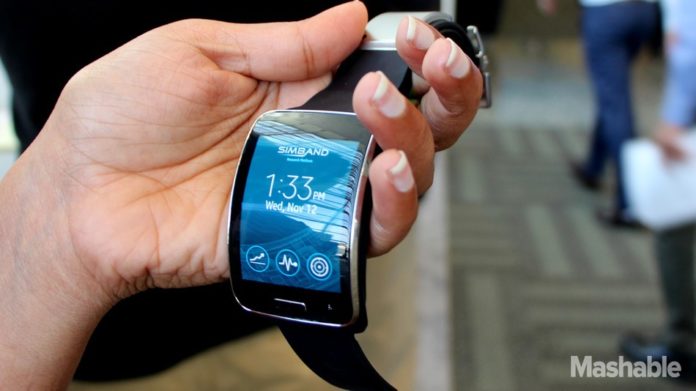First look at Simband, Samsung’s health-tracking wearable of the future

When Samsung first revealed its health-focused wearable Simband earlier this year, the still-speculative device seemed more like an experiment than the futuristic wearable the company promised.
That changed Wednesday when the company revealed new details about its plans for the health-monitoring wearable and announced it was opening up the platform to developers during the keynote presentation at Samsung’s Developer Conference in San Francisco.
But beyond new opportunities for developers, the company — along with a handful of early partners — also offered previews of a fully functioning and sensor-laden Simband. Mashable was on hand to take it for a spin, here’s what we found.
At first glance, the Simband doesn’t look much different than the company’s Gear S smartwatch. A thick rubber band connects to a slightly curved touchscreen display. But the Simband isn’t a smartwatch at all, it isn’t even a consumer device at this point. Instead, Samsung is positioning it as a research device— what Samsung’s Vice President of Health Ram Fish called “a modular reference platform for wearable sensors.”
The Simband is intended to be used by those within the medical industry — startups and medical researchers alike — to develop new applications for sensor technology. It’s part of the company’s broader shift to move its wearables from fitness tracking to health monitoring with the goal of enabling preventive healthcare and wellness.
All about the sensors
The Simband is equipped with six sensors, though its modular design means developers can add their own proprietary sensors as well. The six sensors it comes with can keep tabs on your daily steps, heart rate, blood pressure, skin temperature, and how much sweat your sweat glands are producing.
Together, these sensors are able to keep tabs on a wealth of information. While daily steps and even heart rate monitoring isn’t new ground for wearables, the Simband’s sensors are able to track your bodily functions at an impressively detailed level.

On the back of the Simband is the Simsense module equipped with the Simband’s six different sensors.
Image: Mashable, Karissa Bell
Take the optical sensor, for example, which is used to track blood pressure. It uses LED lights to track changes in how the light is absorbed by your blood, which allows it to “detect blood-volume change at microvascular level,” according to Samsung. Or the galvanic skin sensor (GSR), which keeps tabs on changes in how much sweat your skin is producing. This may seem like an odd metric to track but a Samsung representative said this could be used to measure your stress level, for example.
Trends, monitor and spot check
The home screen displays the time, date and shortcuts to the device’s three main functions: trends, monitor and spot check. Trends is the aforementioned dashboard that displays your data over time, monitor is a real-time tracking mode when all of the band’s sensors are activated and spot check allows you to quickly check your heart rate and blood pressure.
The trends dashboard displays your heart rate, blood pressure, and steps, while allowing you to view how those metrics have changed over the course of the day or week.
Putting the device into monitor mode activates all six of the Simband’s sensors and displays a real-time feed of all the stats being collected.
Spot check is what Fish described as an “electronic version of a nursing station.” Press on the Simband’s clasp, which is connected to a heart-rate sensor, and hold for 20 seconds. After 20 seconds the check is complete and it navigates to the trends dashboard where you can see how your most recent check compares with your previous stats.
But data means nothing if you can’t understand it and the Simband’s software does a pretty good job at putting the measurements into context. Aside from the onboard dashboard, this information can also be tracked on the web when the device has synced over wifi. How it displays information will likely change and improve in the future as more developers are able to create and fine-tune their own applications.
And, of course, it’s still unclear what Samsung’s ambitions for the device beyond research are, if any. But on that front, the company’s current emphasis on research is likely a positive sign. The more time Samsung and its developers spend researching, developing and fine-tuning health applications, the better the whole device will be when and if it makes it out of the lab into our hands.
Have something to add to this story? Share it in the comments.
